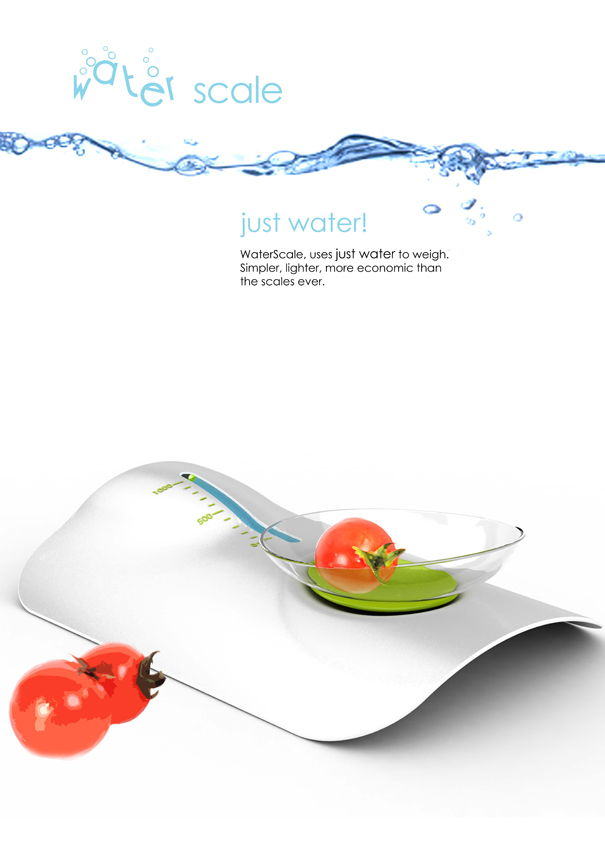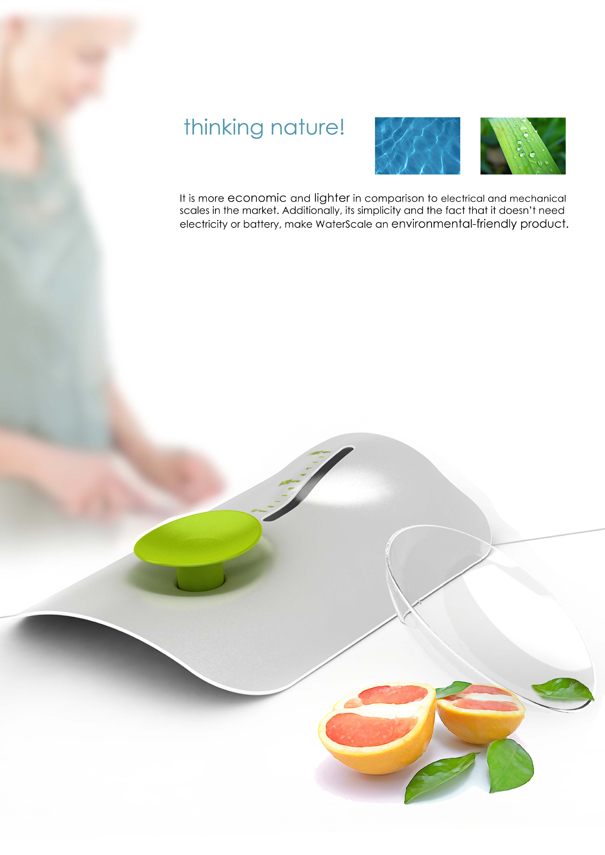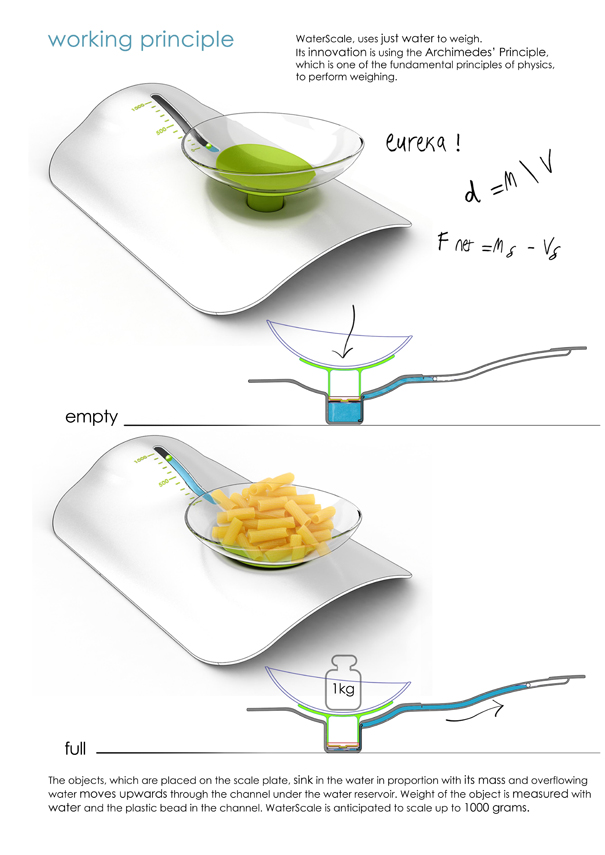BPA Bans, Chemical Reform Laws in the Works in 30 States
by: Greener Design, 2011-01-19 01:05:44 UTC
New bills in 30 states will try to ban bisphenol A and reform the federal government's chemical policies this year.

 Water Weighs All
Water Weighs All
by: Yanko Design, 2011-01-18 08:09:46 UTC
Instead of using all that precious and energy-wasting metal in the construction of a scale, why not use water? That’s what the designer of this fabulous project thought, then he brought it to life – Water Scale, a scale that uses Archimedes’ Principle in a simple container to create just what he thought of in his mind.
The object that is to be weighed is placed ont he scale plate which then sinks into the water in proportion to its mass, overflowing the water which then moves up through channel under the water reservoir. The weight of the object is measured with water and the plastic bead in the channel. This scale can weigh objects up to 1000 grams, and is more economical and lighter than most electric and mechanical scales in the market.
Plus no electricity, no energy consumption – green.
Designer: Muzaffer Kocer & Ayca Guven



----------
Yanko Design
Timeless Designs - Explore wonderful concepts from around the world!
Yanko Design Store - We are about more than just concepts. See what's hot at the YD Store!
Steven Holl Builds Nanjing Museum With Rammed Earth
by: TreeHugger Design, 2011-01-18 17:41:47 UTC
 Images credit Stephen Holl
Images credit Stephen Holl
Ronald Rael of
Earth Architecture shows us yet another great example of rammed earth construction. It's only one of the oldest building materials known to humanity, its main ingredient is as cheap as dirt, it doesn't get any more local and it is gorgeous to look at, particularly in the hands of an architect as talented as Steven Holl. He has used it at the Nanjing Museum of Art and Arch...
Read the full story on TreeHugger
Microfluidics and sunlight combined to purify water
by: Gizmag Emerging Technology Magazine, 2011-01-17 01:24:00 UTC

It has been known for some time now that sunlight can be used to purify drinking water. The practice of Solar Water Disinfection (SODIS) basically involves just leaving water sitting in direct sunlight, where a combination of heat and UV rays kill off waterborne pathogens – the process is called photocatalysis, and it’s what’s at work behind both the
Solaqua water purification device, and a system recently created by students from the
University of Washington. Now, researchers from Hong Kong Polytechnic University have taken things a step further, by combining photocatalysis with microfluidics in a microreactor...
Continue Reading
Microfluidics and sunlight combined to purify waterTags: Microfluidic,
Purification,
Water
Related Articles:


 Fruit fly research could lead to simpler and more robust computer networks
Fruit fly research could lead to simpler and more robust computer networks
by: Gizmag Emerging Technology Magazine, 2011-01-18 05:30:49 UTC

Over the years science has gleaned an enormous amount of knowledge from the humble fruit fly.
Drosophila melanogaster was used to provide the post-Mendelian foundations for our understanding of genetics and has also been used extensively in neuroscience research. The latest fruit fly-inspired innovation could simplify how wireless sensor networks communicate and stands to have wider applications for computing.
..
Continue Reading
Fruit fly research could lead to simpler and more robust computer networksTags: Biomimicry,
Carnegie Mellon,
Computer,
Network
Related Articles:


 Global Observer unmanned aircraft makes first hydrogen-powered flight
Global Observer unmanned aircraft makes first hydrogen-powered flight
by: Gizmag Emerging Technology Magazine, 2011-01-17 07:00:51 UTC

Following on from a successful
maiden flight under battery power in 2010, AeroVironment’s high altitude, long endurance (
HALE) Global Observer unmanned aircraft has now taken to the skies using hydrogen-fueled propulsion. The aircraft reached an altitude of 5,000 feet during the four hour flight on January 11 at Edwards Air Force Base (EAFB) in California. Both the endurance and the altitude of the system will be expanded in further test flights in order to achieve the planned operational altitude of 55,000 to 65,000 feet...
Continue Reading
Global Observer unmanned aircraft makes first hydrogen-powered flightTags: AeroVironment,
HALE,
High Altitude,
Surveillance,
UAV
Related Articles:


 Zeolite-based wood glues shown to absorb pollutants off-gassed from particleboard
Zeolite-based wood glues shown to absorb pollutants off-gassed from particleboard
by: Gizmag Emerging Technology Magazine, 2011-01-14 20:57:16 UTC

It has been estimated that up to 85 percent of all wood materials (such as particleboard or plywood) contain adhesives that in turn contain formaldehyde, and the World Health Organization has classified formaldehyde as a carcinogen. Unfortunately, it’s not enough to simply avoid eating those wood products – even the fumes given off by formaldehyde have been shown to pose a health hazard. Many people turn to keeping spider plants in their homes or offices, as they help neutralize airborne toxins, but now help could be coming from another source. German researchers have discovered that by adding special minerals to wood adhesives, those adhesives themselves can help clean the air...
Continue Reading
Zeolite-based wood glues shown to absorb pollutants off-gassed from particleboardTags: Adhesive,
Air purification system,
Emissions,
Glue,
Pollution,
toxic,
Wood
Related Articles:


 Pigments from peanuts: a better way to make dyes from agricultural waste
Pigments from peanuts: a better way to make dyes from agricultural waste
by: Gizmag Emerging Technology Magazine, 2011-01-17 00:40:34 UTC

Researchers at the Argentine National Institute for Industrial Technology (INTI) are taking a new approach to the manufacture of natural dyes from agricultural waste. The method involves extraction of pigments from waste and conserving them in dust form, meaning they can be dry stored for use all year round. Over the past year numerous agricultural materials have been tested with one of the most promising candidates being peanut shells – one of Argentina's main exports...
Continue Reading
Pigments from peanuts: a better way to make dyes from agricultural wasteTags: Agri-waste,
Dye,
Peanut,
textile
Related Articles:


 Biolamp streetlamp converts smog into fuel to power eco cars
Biolamp streetlamp converts smog into fuel to power eco cars
by: The Design blog, 2011-01-17 12:29:06 UTC

Over the period, smog due to increasing number of vehicles and industries has becoming a major concern for the environment and health of people living in urbanities. Addressing the issue, Hungarian designer Peter Horvath has popped up a creative solution, the “Biolamp,” which converts carbon-dioxide into fuel to power the street lamps, other than providing a clean and healthy environment for the city dwellers. Containing a liquid, alga mixed with water, which transforms CO2 into oxygen, the sustainable streetlamp also includes a pump to suck the smog, from the top, and circulate the liquid in the spiral system. During the daytime, the streetlamp uses sunlight, CO2 and water to transform the alga into biomass that can be converted into fuel to power the lamps as well. As soon as the alga liquid is saturated with carbon-dioxide, the biomass is driven to the closest filler station through underground tubes, where it is transformed into biofuel to power eco cars, and refuel street lamps with alga thereafter.


[Cheers Peter]


 Metafore Further Meshes EPAT Paper-Buying Tool with Green Efforts
Metafore Further Meshes EPAT Paper-Buying Tool with Green Efforts
by: Greener Design, 2011-01-13 14:00:59 UTC
The latest update to the Environmental Paper Assessment Tool offers deeper data on the environmental impacts of paper production, helping companies make the greenest choices and achieve their supply chain sustainability goals.








Comments by our Users
Be the first to write a comment for this item.